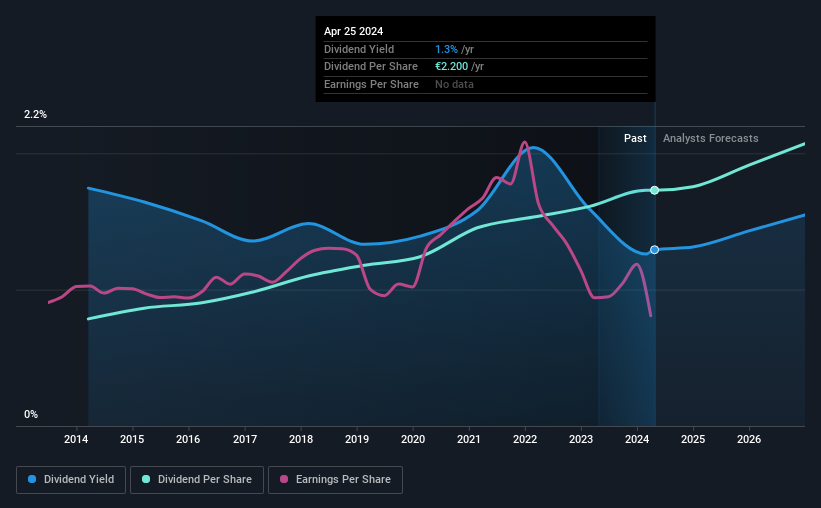SAP's (ETR:SAP) Upcoming Dividend Will Be Larger Than Last Year's
SAP SE (ETR:SAP) has announced that it will be increasing its dividend from last year's comparable payment on the 21st of May to €2.20. Based on this payment, the dividend yield for the company will be 1.3%, which is fairly typical for the industry.
See our latest analysis for SAP
SAP's Payment Has Solid Earnings Coverage
While it is always good to see a solid dividend yield, we should also consider whether the payment is feasible. Based on the last payment, SAP's profits didn't cover the dividend, but the company was generating enough cash instead. Given that the dividend is a cash outflow, we think that cash is more important than accounting measures of profit when assessing the dividend, so this is a mitigating factor.
According to analysts, EPS should be several times higher next year. If recent patterns in the dividend continue, we could see the payout ratio reaching 34% which is fairly sustainable.
SAP Has A Solid Track Record
The company has an extended history of paying stable dividends. Since 2014, the dividend has gone from €1.00 total annually to €2.20. This works out to be a compound annual growth rate (CAGR) of approximately 8.2% a year over that time. Companies like this can be very valuable over the long term, if the decent rate of growth can be maintained.
SAP May Find It Hard To Grow The Dividend
Investors could be attracted to the stock based on the quality of its payment history. However, things aren't all that rosy. SAP has seen earnings per share falling at 4.1% per year over the last five years. If earnings continue declining, the company may have to make the difficult choice of reducing the dividend or even stopping it completely - the opposite of dividend growth. Earnings are forecast to grow over the next 12 months and if that happens we could still be a little bit cautious until it becomes a pattern.
In Summary
Overall, we always like to see the dividend being raised, but we don't think SAP will make a great income stock. The company is generating plenty of cash, but we still think the dividend is a bit high for comfort. Overall, we don't think this company has the makings of a good income stock.
Market movements attest to how highly valued a consistent dividend policy is compared to one which is more unpredictable. Meanwhile, despite the importance of dividend payments, they are not the only factors our readers should know when assessing a company. For instance, we've picked out 1 warning sign for SAP that investors should take into consideration. Looking for more high-yielding dividend ideas? Try our collection of strong dividend payers.
Have feedback on this article? Concerned about the content? Get in touch with us directly. Alternatively, email editorial-team (at) simplywallst.com.
This article by Simply Wall St is general in nature. We provide commentary based on historical data and analyst forecasts only using an unbiased methodology and our articles are not intended to be financial advice. It does not constitute a recommendation to buy or sell any stock, and does not take account of your objectives, or your financial situation. We aim to bring you long-term focused analysis driven by fundamental data. Note that our analysis may not factor in the latest price-sensitive company announcements or qualitative material. Simply Wall St has no position in any stocks mentioned.

 Yahoo Finance
Yahoo Finance 
